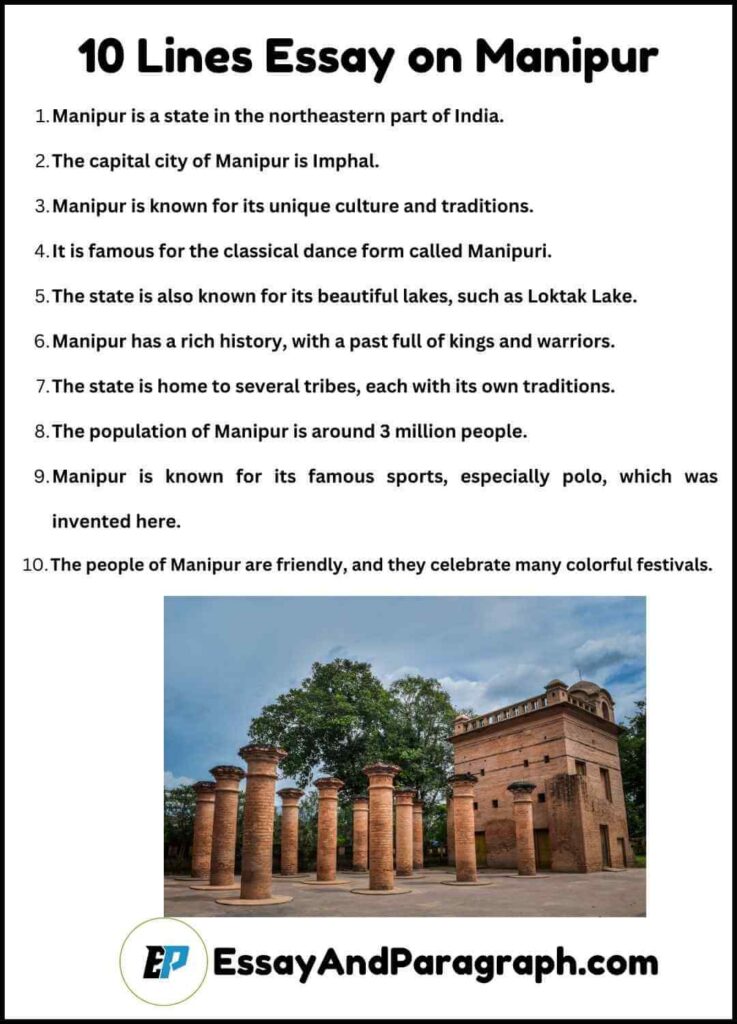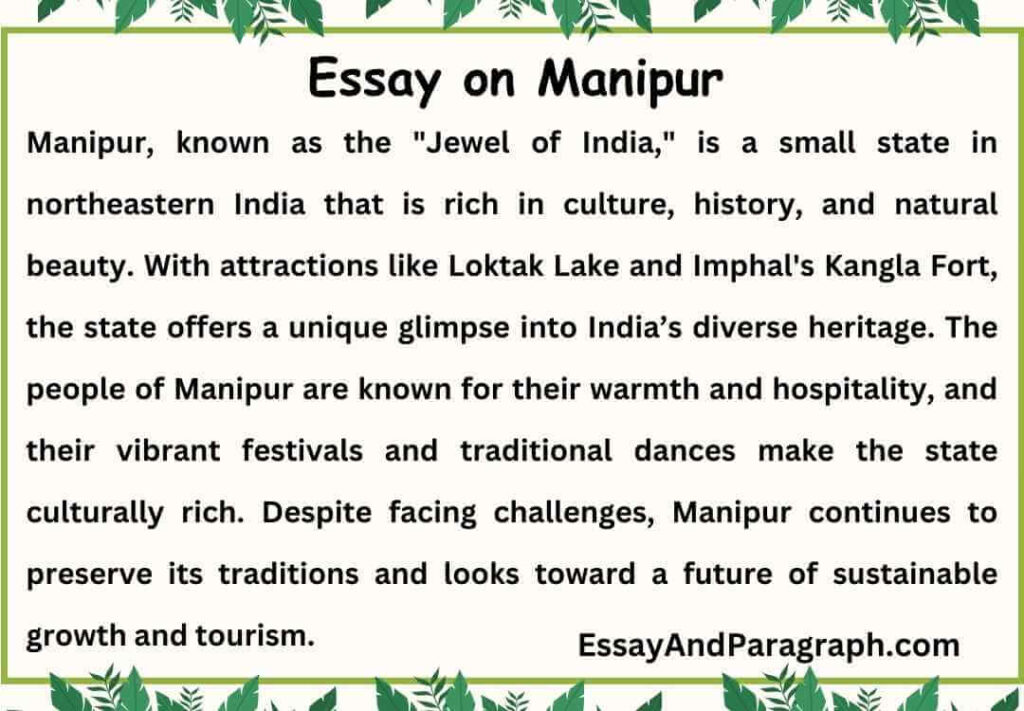Ever heard of Manipur? It is a small but stunning state located in the northeastern part of India. Known for its rich culture, beautiful landscapes, and historic significance, Manipur is a land that offers much to explore. From its famous classical dance form, Manipuri, to its natural beauty, it’s a place that captivates anyone who visits. In this article, we will learn how to write an essay on Manipur and explore its culture, history, and natural charm.
10 Lines Essay on Manipur in English
- Manipur is a state in the northeastern part of India.
- The capital city of Manipur is Imphal.
- Manipur is known for its unique culture and traditions.
- It is famous for the classical dance form called Manipuri.
- The state is also known for its beautiful lakes, such as Loktak Lake.
- Manipur has a rich history, with a past full of kings and warriors.
- The state is home to several tribes, each with its own traditions.
- The population of Manipur is around 3 million people.
- Manipur is known for its famous sports, especially polo, which was invented here.
- The people of Manipur are friendly, and they celebrate many colorful festivals.

Short Essay on Manipur in English
Manipur is a beautiful state located in the northeastern part of India. It is known for its rich cultural heritage, natural beauty, and peaceful atmosphere. The state’s capital, Imphal, is a bustling city surrounded by hills and valleys. One of the most famous attractions in Manipur is Loktak Lake, which is the largest freshwater lake in northeastern India.
Manipur is also home to many indigenous tribes, including the Meitei, Naga, and Kuki tribes. Each tribe has its own unique traditions, language, and festivals. The Manipuri dance, which is performed during religious festivals, is one of the oldest classical dance forms in India. The state is also known for its traditional martial arts and sports, such as the game of polo, which is said to have originated here.
The people of Manipur are very hospitable and are known for their warmth and friendliness. Agriculture is the main source of livelihood for most of the population, with rice being the staple food. The state also has a rich tradition of arts and crafts, including handloom weaving, pottery, and traditional music.
Long Essay on Manipur in English for Students
Manipur, a small yet culturally rich state in northeastern India, is often referred to as the “Jewel of India” due to its stunning landscapes and rich traditions. The state is bordered by Nagaland to the north, Mizoram to the south, and Myanmar to the east. Manipur is known for its breathtaking natural beauty, including hills, valleys, and lush green forests. One of the most famous attractions in the state is Loktak Lake, which is the largest freshwater lake in the northeastern region of India. The lake is known for its floating islands, called phumdis, which add to the mystique and charm of the area.
The capital city, Imphal, is the heart of the state’s culture and history. It is home to several historical monuments, including the Kangla Fort, which was once the seat of Manipur’s kings. The city is also known for its vibrant bazaars, where visitors can experience the state’s unique handicrafts, traditional clothing, and delicious local food.
Manipur is a melting pot of diverse ethnic groups, with tribes such as the Meitei, Naga, Kuki, and Tangkhul making up the population. Each tribe has its own distinct language, customs, and festivals. The Meitei people, who are the majority in the state, are known for their classical Manipuri dance, a graceful and spiritual form of dance that has been passed down through generations. Manipuri dance is performed during festivals and religious ceremonies, and it is an important part of the state’s cultural identity.
In addition to its dance and cultural heritage, Manipur is also known for its sports. Polo, one of the oldest team sports in the world, is said to have originated in Manipur. The state also has a strong tradition of martial arts, with local forms like Thang-Ta and Sarit Sarak being practiced by many. These sports not only keep the traditions alive but also foster a sense of discipline and community among the people.
The economy of Manipur is primarily agricultural, with rice, maize, and vegetables being the main crops grown in the state. However, Manipur has also made strides in other industries, such as handloom weaving, pottery, and handicrafts. The state is known for its fine silk textiles, which are highly valued for their intricate designs and craftsmanship.
Despite its rich history and culture, Manipur faces challenges like any other state. Issues such as political unrest, infrastructure development, and economic growth remain areas of concern. However, the people of Manipur continue to work hard to overcome these obstacles while preserving their traditions and way of life.
Looking ahead, Manipur is focusing on developing its tourism industry while maintaining its cultural heritage. The state’s rich history, vibrant culture, and natural beauty have the potential to attract visitors from around the world. By promoting sustainable tourism and preserving its natural resources, Manipur has the opportunity to grow while maintaining its identity as one of India’s most unique and beautiful states.
FAQs about Essay on Manipur
What is Manipur famous for?
Manipur is famous for its rich culture, traditional dance forms, and stunning natural beauty. The state is known for Loktak Lake, the largest freshwater lake in northeastern India, and the classical Manipuri dance, which is an important part of its heritage. Manipur is also known for its martial arts, including Thang-Ta, and its sports, particularly polo, which was invented here. The state’s diverse tribes and vibrant festivals also make it a unique destination in India.
What is the population of Manipur?
Manipur has a population of around 3 million people. The state is home to various indigenous tribes, including the Meitei, Kuki, Naga, and Tangkhul tribes, each with its own distinct traditions, language, and customs. Despite its small size, Manipur is a culturally diverse state, with a unique blend of indigenous and modern influences.
What are the major tribes in Manipur?
The major tribes of Manipur include the Meitei, Kuki, Naga, and Tangkhul tribes. The Meitei people, who are the majority in the state, are known for their classical dance, Manipuri, and their unique customs. The Kuki, Naga, and Tangkhul tribes have their own traditions, languages, and festivals, adding to the rich cultural tapestry of the state.
What are some popular tourist attractions in Manipur?
Some of the popular tourist attractions in Manipur include Loktak Lake, the Kangla Fort, and the Imphal War Cemetery. Loktak Lake, with its floating islands, is one of the most famous landmarks in the state. The Kangla Fort, located in Imphal, is a historic site that once served as the royal palace of Manipur’s kings. The state also boasts several vibrant markets, temples, and natural landscapes that attract tourists from all over India and abroad.
What is the traditional food of Manipur?
The traditional food of Manipur includes rice, vegetables, and fish. One of the most popular dishes is “Eromba,” a spicy preparation made with mashed vegetables and fermented fish. Another staple food is “Nga Thongba,” a fish curry made with fresh fish and aromatic spices. Manipur’s cuisine is known for its simple yet flavorful ingredients, with a focus on freshness and natural flavors.

Top 5 Quotes on Manipur
- “Manipur, a land where history and culture dance together in harmony.”
- “In the heart of Manipur, every hill tells a story, and every river sings a song.”
- “The people of Manipur are like the land itself – strong, resilient, and beautiful.”
- “From the floating islands of Loktak Lake to the graceful Manipuri dance, Manipur is India’s best-kept secret.”
- “Manipur’s beauty is not just seen in its landscapes, but felt deeply in its people’s hearts.”
Summary about Essay on Manipur
Manipur, known as the “Jewel of India,” is a small state in northeastern India that is rich in culture, history, and natural beauty. With attractions like Loktak Lake and Imphal’s Kangla Fort, the state offers a unique glimpse into India’s diverse heritage. The people of Manipur are known for their warmth and hospitality, and their vibrant festivals and traditional dances make the state culturally rich. Despite facing challenges, Manipur continues to preserve its traditions and looks toward a future of sustainable growth and tourism.

